Botulism
{{#meta: itemprop="medicalWebPageAudiences" content="patient"}}{{#meta: itemprop="medicalWebPageSpecialities" content="cardiology"}}{{#meta: itemprop="medicalWebPageInfoTypes" content="symptoms,diagnosis,treatment,causes,prognosis,complications"}} Classification Classic::Classification Atypical::
Overview
|
Botulism Microchapters |
|
Diagnosis |
|---|
|
Treatment |
|
Case Studies |
|
Botulism On the Web |
|
American Roentgen Ray Society Images of Botulism |
Editor-In-Chief: C. Michael Gibson, M.S., M.D. [1] Michael Maddaleni, B.S.
Overview
Botulism (Latin, botulus, sausage) is a rare, but serious paralytic illness caused by a nerve toxin, botulin, that is produced by the bacterium Clostridium botulinum. Botulinic toxin is one of the most powerful known toxins: about one microgram is lethal to humans. It acts by blocking nerve function and leads to respiratory and musculoskeletal paralysis. Botulism is an acute paralytic illness caused by a neurotoxin produced by Clostridium botulinum. Supportive care, including intensive care, is key but the role of other medical treatments is unclear. Botulism is an acute paralytic rare illness with a high mortality rate. It is caused by the action of bacterium Clostridium botulinum neurotoxin. yet there is no known medical treatment for it. Supportive care, including intensive care, is the best treatment for now.[1][2]
Historical perspective
Clostridium botulinum botulism was named In 1870 by Muller (German physician). In 1895 Clostridium botulinum was first isolated by Emile Van Ermengem and It was in 1949 when Burgen's group discovered that botulinum toxin blocks neuromuscular transmission.
Classification
Botulism can be classified into foodborne, wound and infant botulism. Iatrogenic botulism and adult intestinal toxemia are rare types of botulism. They are differed from each other according to the mode of infection and the clinical presentation.
Pathophysiology
Botulism is most commonly caused by neurotoxins produced by C. botulinum. but C. baratii produces similar neurotoxins (5, 6). The neurotoxins which cause botulism are the most potent toxins currently known and cause paralysis through the inhibition of acetlylcholine release in human nerve endings. Clostridium botulinum is an obligate anaerobe that forms spores.
Causes
Clostridium botulinum is found in soil and untreated water throughout the world. It produces spores that survive in improperly preserved or canned food, where they produce toxin. When eaten, even tiny amounts of this toxin can lead to severe poisoning. The foods most commonly contaminated are home-canned vegetables, cured pork and ham, smoked or raw fish, and honey or corn syrup. Botulism may also occur if the organism enters open wounds and produces toxin there. Infant botulism occurs when living bacteria or its spores are eaten and grow within the baby's gastrointestinal tract. The most common cause of infant botulism is eating honey or corn syrup. Clostridium botulinum also occurs normally in the stool of some infants.
It has also been speculated that it is possible to acquire botulism through inhalation. So far, the only human cases of this occurring have been due to factory workers inadvertently inhaling it. It has been suspected that the botulinun toxin could be aerosolized into a weapon for use in a bioterrorist attack.
Differentiating botulism from other diseases
Botulism must be differentiated from neuromuscular disorders, neurotoxins, infections, and vascular diseases that present with muscle weakness, hypotonia, and flaccidity.
Epidemiology and demographics
Globally, botulism is fairly rare. In the United States, for example, an average of 110 cases are reported each year. Of these, roughly 70% are infant botulism, 25% are foodborne botulism, and 5% are wound botulism. The number of cases of food borne and infant botulism has changed little in recent years, but wound botulism has increased because of the use of black tar heroin, especially in California.[3] Wound botulism may be caused even by inhaled cocaine.
Risk Factors
Botulism risk factors can be based upon the different types of the disease. The infants are more vulnerable to get infected with botulinum toxin. Honey and corn ingestion are common risk factors for the infants to get infected. Ingestion of preformed food and canned food increase the susceptibility of the infection. The intravenous drug abusers are vulnerable to get infected with wound botulism as well.
Screening
According to the United States Preventive Services Task Force (USPSTF), there are no screening recommendations for botulism. [4]
Natural history, complications and prognosis
If botulism left untreated it may cause respiratory failure and even death. Common complications of botulism include, respiratory failure, difficult swallowing, speech difficulties, fatigue, and death. Botulism's prognosis depends on the amount of the ingested toxins and prompt treatment.
Diagnosis
History and symptoms
Botulism symptoms ranges from mild to very severe in some cases. The common symptoms generally are nausea, vomiting, diarrhea and dysphagia. The common symptoms in adult are double vision, blurred vision and slurred speech. The common in the infants constipation and weak crying. Botulism affects mainly the nervous system and may lead to paralysis.
Physical examination
Botulism physical examination is very important in order to suggest or exclude the disease. The patients with botulism appear dizzy and tired. The following signs are observed in the botulism patients: eyelid dropping, weakness of tongue muscle, nystagmus and decreased gag reflex. Paralytic ileus also may present. Botulism presentation shows many neurological manifestations like: generalized muscle weakness, abscent tendon reflexes, facial nerve impairment and speech impairment.[5][6]
Laboratory Findings
Clinical diagnosis of botulism is confirmed by specialized laboratory testing that often requires days to complete. Routine laboratory test results are usually unremarkable. Therefore, clinical diagnosis is the foundation for early recognition of and response to a bioterrorist attack with botulinum toxin, and all treatment and management decisions should be made based on clinical diagnosis.
CT
There are no CT findings associated with botulism.
MRI
There are no MRI findings associated with botulism.
Other Diagnostic Studies
There are no other diagnostic findings associated with botulism.
Treatment
Medical Therapy
The mainstay of therapy for botulism is antitoxin therapy. Antimicrobial therapy is recommended for wound botulism after antitoxin has been administered. Breathing requires the use of many muscles, inluding the diaphragm. Therefore, botulism will make breathing very difficult and interventions to aid in the breathing process will be essential. Many people with botulism will need to be on a mechanical ventilator for a significant period of time. There are also other therapies such as antitoxin treatment. This method is not readily used on infants because of adverse side effects.
Surgery
Surgical intervention is not recommended in the treatment of botulism.
Primary Prevention
Secondary Prevention
After someone has been exposed to the clostridium botulinum bacteria, there needs to be ways to stop it from spreading and eventually causing damage to the host. This can be done through different techniques such as administering antitoxin and decontaminating suspected food sources.
Cost-Effectiveness of Therapy
Since there are only a few major treatments for Botulism, the financial aspect of the treatment will be relatively straight forward. The financial costs will revolve around things such as a prolonged hospital stay as well as antitoxin therapy. It should also be noted that cosmetic Botox will be at a different cost.
Future or Investigational Therapies
Classically, the treatment for botulism has been to deliver an antitoxin to the patient once exposed. Also, putting the patient on a mechanical ventilator has been a successful treatment method because patients with botulism have extreme trouble breathing on their own. Even though these treatments have been successful, there have been tests on a new drug that will block potassium channels in order to restore neuromuscular function after botulinum intoxication.
References
- ↑ Brown N, Desai S (2013). "Infantile botulism: a case report and review". J Emerg Med. 45 (6): 842–5. doi:10.1016/j.jemermed.2013.05.017. PMID 23871478 Check
|pmid=value (help). - ↑ Chalk CH, Benstead TJ, Keezer M (2014). "Medical treatment for botulism". Cochrane Database Syst Rev (2): CD008123. doi:10.1002/14651858.CD008123.pub3. PMID 24558013.CS1 maint: Multiple names: authors list (link)
- ↑ Invalid
<ref>tag; no text was provided for refs named:0 - ↑ https://www.uspreventiveservicestaskforce.org/BrowseRec/Search?s=Botulism. United States Preventive Services Task Force. Accessed on 05/22/2017
- ↑ Hughes JM, Blumenthal JR, Merson MH, Lombard GL, Dowell VR, Gangarosa EJ (1981). "Clinical features of types A and B food-borne botulism". Ann Intern Med. 95 (4): 442–5. PMID 7283294.CS1 maint: Multiple names: authors list (link)
- ↑ Fenicia L, Anniballi F (2009). "Infant botulism". Ann Ist Super Sanita. 45 (2): 134–46. PMID 19636165.
Historical Perspective
|
Botulism Microchapters |
|
Diagnosis |
|---|
|
Treatment |
|
Case Studies |
|
Botulism On the Web |
|
American Roentgen Ray Society Images of Botulism |
Editor-In-Chief: C. Michael Gibson, M.S., M.D. [2]; Associate Editor(s)-in-Chief: Michael Maddaleni, B.S.
Overview
Clostridium botulinum botulism was named In 1870 by Muller (German physician). In 1895 Clostridium botulinum was first isolated by Emile Van Ermengem and It was in 1949 when Burgen's group discovered that botulinum toxin blocks neuromuscular transmission.
Historical Perspective
Food-borne botulism may be one of the first illnesses that has accompanied mankind since its beginning. The documents containing historical soureces and perspective on food poisoning before the 19th century have not been found yet. As there are some ancient dietary laws and taboos, some knowledge about the life-threatening consumption of poisoned foods may be reflected by them. One example of such a dietary taboo is the 10th century edict of Emperor Leo VI of Byzantium in which manufacturing of blood sausages was forbidden[1]. There are also ancient case reports on intoxications with Atropa belladonna that seems like symptoms of patients with food-borne botulism, because the combination of dilated pupils and fatal muscle paralysis cannot be attributed to an atropine intoxication, although it was different they didn't think about it as a new disease. At the end of the 18th century, some well-documented outbreaks of “sausage poisoning” in Southern Germany, especially in Württemberg, led to early systematic botulinum toxin research. The first accurate and complete description of the clinical symptoms of food-borne botulism was published between 1817 and 1822 by the German physician and poet Justinus Kerner (1786–1862). He called the toxin as “sausage poison” or "Canadian bacon pathogen". He also developed the idea of a possible therapeutic use of botulinum toxin. Kerner’s had an amazing scientific approach to the problems of food poisoning during the period of enlightenment: after describing and categorizing empirical phenomena, he started animal experiments and clinical experiments on himself, developed hypotheses on the pathophysiology of the toxin, suggested measures for prevention and treatment of botulism, and, finally, developed visions and ideas about future perspectives regarding the toxin, including the idea of its therapeutic use[2]. Although his amazing work, Kerner did not succeed in defining the suspected biological poison. Eighty years after Kerner's work, in 1895, a botulism outbreak after a funeral dinner with smoked ham in the small Belgian village of Ellezelles led to the discovery of the pathogen Clostridium botulinum by Emile Pierre van Ermengem, Professor of bacteriology at the University of Ghent. The bacterium was so called because of its pathological association with the sausages (Latin word for sausage = “botulus”) and although its shape is truely like a sausage, the reason they call ii is not associated with its microscopic shape. Modern botulinum toxin treatment which is known as chemodenervation therapy was pioneered by Alan B. Scott and Edward J Schantz in 1973 with monkey experiments and in 1980 with human applications.
United States
All data regarding botulism antitoxin releases and laboratory confirmation of cases in the US are recorded annually by the Centers for Disease Control and Prevention and published on their website.[3]
- 1971 Bon Vivant botulism case On July 2, 1971, the U.S. Food and Drug Administration (FDA) released a public warning after learning that a New York man had died and his wife had become seriously ill due to botulism after eating a can of Bon Vivant vichyssoise soup.
- Between March 31 and April 6, 1977, 59 individuals developed type B botulism. All ill persons had eaten at the same Mexican restaurant in Pontiac, Michigan and all had consumed a hot sauce made with improperly home-canned jalapeño peppers, either by adding it to their food, or by eating a nacho that had had hot sauce used in its preparation. The full clinical spectrum (mild symptomatology with neurologic findings through life-threatening ventilatory paralysis) of type B botulism was documented.[4]
- In April 1994, the largest outbreak of botulism in the United States since 1978 occurred in El Paso, Texas. Thirty persons were affected; 4 required mechanical ventilation. All ate food from a Greek restaurant. The attack rate among persons who ate a potato-based dip was 86% (19/22) compared with 6% (11/176) among persons who did not eat the dip (relative risk [RR] Å 13.8; 95% confidence interval [CI], 7.6–25.1). The attack rate among persons who ate an eggplant-based dip was 67% (6/9) compared with 13% (24/189) among persons who did not (RR Å 5.2; 95% CI, 2.9–9.5). Botulism toxin type A was detected from patients and in both dips. Toxin formation resulted from holding aluminum foil-wrapped baked potatoes at room temperature, apparently for several days, before they were used in the dips. Food handlers should be informed of the potential hazards caused by holding foil-wrapped potatoes at ambient temperatures after cooking.[5]
- Beginning in late June 2007, 8 people contracted botulism poisoning by eating canned food products produced by Castleberry's Food Company in its Augusta, Georgia plant. It was later identified that the Castleberry's plant had serious production problems on a specific line of retorts that had under-processed the cans of food. These issues included broken cooking alarms, leaking water valves and inaccurate temperature devices, all the result of poor management of the company. All of the victims were hospitalized and placed on mechanical ventilation. The Castleberry's Food Company outbreak was the first instance of botulism in commercial canned foods in the United States in over 30 years.
- One person died, 21 cases were confirmed, and 10 more were suspected in Lancaster, Ohio when a botulism outbreak occurred after a church potluck in April 2015. The suspected source was a salad made from home-canned potatoes. [6]
United Kingdom
The largest recorded outbreak of foodborne botulism in the United Kingdom occurred in June 1989. A total of 27 patients were affected; one patient died. Twenty-five of the patients had eaten one brand of hazelnut yogurt in the week before the onset of symptoms. This yogurt contained hazelnut conserve sweetened with aspartame rather than sugar. Control measures included the cessation of all yogurt production by the implicated producer, the withdrawal of the firm's yogurts from sale, the recall of cans of the hazelnut conserve, and advice to the general public to avoid the consumption of all hazelnut yogurts.[7]
Botulinum Toxin as a Therapy
By 1973, Alan B Scott, MD, of Smith-Kettlewell Institute used botulinum toxin type A (BTX-A) in monkey experiments, and, in 1980, he officially used BTX-A for the first time in humans to treat strabismus. In December 1989, BTX-A (BOTOX) was approved by the US Food and Drug Administration (FDA) for the treatment of strabismus, blepharospasm, and hemifacial spasm in patients over 12 years old. The cosmetic effect of BTX-A was initially described by ophthalmologist Jean Carruthers and dermatologist Alastair Carruthers, a husband-and-wife team working in Vancouver, Canada, although the effect had been observed by a number of independent groups. On April 15, 2002, the FDA announced the approval of botulinum toxin type A (BOTOX Cosmetic) to temporarily improve the appearance of moderate-to-severe frown lines between the eyebrows (glabellar lines). BTX-A has also been approved for the treatment of excessive underarm sweating. Botulinum Toxin Type B (BTX-B) received FDA approval for treatment of cervical dystonia on December 21, 2000. Trade names for BTX-B are Myobloc in the United States, and Neurobloc® in the European Union.The acceptance of BTX-A use for the treatment of spasticity and muscle pain disorders is growing, with approvals pending in many European countries and studies on headaches (including migraine), prostatic symptoms, asthma, obesity and many other possible indications are ongoing.
Botox is manufactured by Allergan Inc (U.S.) for both therapeutic as well as cosmetic use. The formulation is best stored at cold temperature of 2-8 degrees Celsius. Dysport is a therapeutic formulation of the type A toxin developed and manufactured in the UK and which is licensed for the treatment of focal dystonias, symptoms of cerebral palsy, and certain cosmetic uses in many territories world wide.
References
- ↑ Erbguth FJ (2004). "Historical notes on botulism, Clostridium botulinum, botulinum toxin, and the idea of the therapeutic use of the toxin". Mov. Disord. 19 Suppl 8: S2–6. doi:10.1002/mds.20003. PMID 15027048.
- ↑ Erbguth FJ, Naumann M (1999). "Historical aspects of botulinum toxin: Justinus Kerner (1786-1862) and the "sausage poison"". Neurology. 53 (8): 1850–3. PMID 10563638.
- ↑ "National Case Surveillance: National Botulism Surveillance | CDC National Surveillance". Cdc.gov. 2013-06-25. Retrieved 2014-02-12.
- ↑ Terranova, William; Breman, Joel G.; Locey, Robert P.; Speck, Sarah (1978). "Botulism type B: epidemiologic aspects of an extensive outbreak". American Journal of Epidemiology. 108 (2): 150–6. PMID 707476.
- ↑ Angulo, F. J.; Getz, J.; Taylor, J. P.; Hendricks, K. A.; Hatheway, C. L.; Barth, S. S.; Solomon, H. M.; Larson, A. E.; Johnson, E. A.; Nickey, L. N.; Ries, A. A. (1998). "A Large Outbreak of Botulism: The Hazardous Baked Potato". Journal of Infectious Diseases. 178 (1): 172–7. doi:10.1086/515615. PMID 9652437.
- ↑ "1 dead in botulism outbreak linked to Ohio church potluck". CNNWIRE. CNN. 28 April 2015. Retrieved 19 July 2015.
- ↑ O'Mahony, M; Mitchell, E; Gilbert, RJ; Hutchinson, DN; Begg, NT; Rodhouse, JC; Morris, JE (1990). "An outbreak of foodborne botulism associated with contaminated hazelnut yoghurt". Epidemiology and Infection. 104 (3): 389–95. PMC 2271776. PMID 2347382.
Pathophysiology
|
Botulism Microchapters |
|
Diagnosis |
|---|
|
Treatment |
|
Case Studies |
|
Botulism On the Web |
|
American Roentgen Ray Society Images of Botulism |
Editor-In-Chief: C. Michael Gibson, M.S., M.D. [3]; Associate Editor(s)-in-Chief: Michael Maddaleni, B.S.
Overview
Botulism is most commonly caused by neurotoxins produced by C. botulinum. but C. baratii produces similar neurotoxins (5, 6). The neurotoxins which cause botulism are the most potent toxins currently known and cause paralysis through the inhibition of acetlylcholine release in human nerve endings. Clostridium botulinum is an obligate anaerobe that forms spores.
Pathophysiology
Botulism is most commonly caused by neurotoxins produced by C. botulinum, but C. baratii produces similar neurotoxins (5, 6). These toxins have been designated by letters, and human botulism has been caused by toxins A, B, E, and F.
The neurotoxins which cause botulism are the most potent toxins currently known and cause paralysis through the inhibition of acetlylcholine release in human nerve endings
Symptoms may begin as a headache and vomiting and progress to proximal and then distal paralysis (6). Eventually respiratory failure may occur due to paralysis and the morality rate for botulism is currently only 3 to 5 percent, in part due to mechanical respiration technology
The video presented here is of Botulinum toxin B and provides a general overview of the cause of Botulism. It describes the mechanism of action that the toxin takes within the nerve cells.
Clostridium botulinum is an obligate anaerobe that forms spores. The natural habitat for the Clostridium botulinum spores is the soil. The species of Clostridium botulinum is made up of 4 genetically diverse groups that do not have much in common other than the fact that they all produce the botulinum toxin.[1] The botulinum toxin itself exists as 7 different antigenic types and these 7 antigenic types have been assigned a series of letters: A, B, C, D, E, F, G.[1] These toxins have a specific definition, and they are defined by their inability to cross neutralize the other types. For example, Anti-A toxin can not neutralize any of the other toxin types (B-G). It should be noted that Clostridium baratii and Clostridium butyricum can also produce the botulinum toxin.[1]
The botulinum molecule itself is composed of a heavy chain as well as a light chain polypeptide. It is referred to as a dichain polypeptide. The light chain of the toxin contains an endopeptidase that blocks acetylcholine-containing vesicles from being able to fuse with the membrane at the end of the motor neuron. If acetycholine is not present, it will result in flaccid muscle paralysis.[1]
Many people may not realize it, but the commercial therapeutic procedure termed "Botox" actually contains the botulinum toxin. However, there is a very small amount of it present, otherwise it would present an extensive danger. A vial of type A preparation, which is currently licensed in the US, contains only about 0.005% of the lethal oral dose and 0.3% of the lethal inhalation dose.[1]
Clostridium botulinum is divided into 4 groups:
- Group I - can produce toxins specifically A, B, or F proteolytic
- Group II - can produce toxins specifically B, E, or F, nonproteolytic
- Group III - can produce toxins C or D
- Group IV - can produce toxin G but toxin G has not been shown to cause neuroparalytic illness.
Honey, corn syrup, and other sweeteners are potentially dangerous for infants. This is partly because the digestive juices of an infant are less acidic than older children and adults, and may be less likely to destroy ingested spores. In addition, young infants do not yet have sufficient numbers of resident microbiota in their intestines to competitively exclude C. botulinum. Unopposed in the small intestine, the warm body temperature combined with an anaerobic environment creates a medium for botulinum spores to germinate, divide and produce toxin. Thus, C. botulinum is able to colonize the gut of an infant with relative ease, whereas older children and adults are not typically susceptible to ingested spores. C. botulinum spores are widely present in the environment, including honey. For this reason, it is advised that neither honey, nor any other sweetener, be given to children until after 12 months. Nevertheless, the majority of infants with botulism have no history of ingestion of honey, and the exact source of the offending spores is unclear about 85% of the time. Spores present in the soil are a leading candidate for most cases, and often a history of construction near the home of an affected infant may be obtained.
Gross Pathology
Shown below is an image of contaminated Jalapeño peppers involved in an outbreak of botulism in Pontiac, Michigan, April, 1977. Ingestion of botulinal toxin results in an illness of variable severity. Common symptoms are diplopia, blurred vision, and bulbar weakness. Symmetric paralysis may progress rapidly. This is a close up of contaminated Jalapeño peppers involved in an outbreak of botulism in Pontiac, Michigan, April, 1977. Ingestion of botulinal toxin results in an illness of variable severity. Common symptoms are diplopia, blurred vision, and bulbar weakness. Symmetric paralysis may progress rapidly.

Shown below is an image of Clostridium botulinum Type E colonies displaying an opaque zone grown on a 48hr egg yolk agar plate; Mag. 1.9 C. botulinum Type E is an indigenous organism in the aquatic environment, and is the type mainly associated with botulism from seafood products. It is a Gram-positive, anaerobic, -forming food borne pathogen.
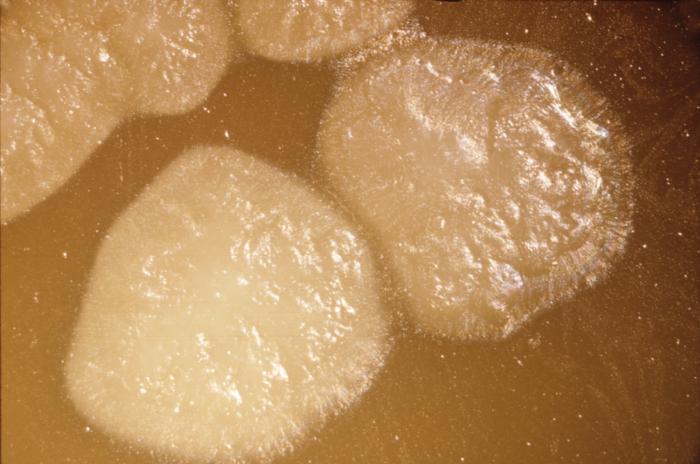
Shown below is an image of this is a Clostridium botulinum type A colony grown on a 72 hour blood agar plate; Magnification 5X. The bacterium C. botulinum produces a nerve toxin, which causes the rare, but serious paralytic illness Botulism. There are seven types of botulism toxin designated by the letters A through G; only types A, B, E and F cause illness in humans.
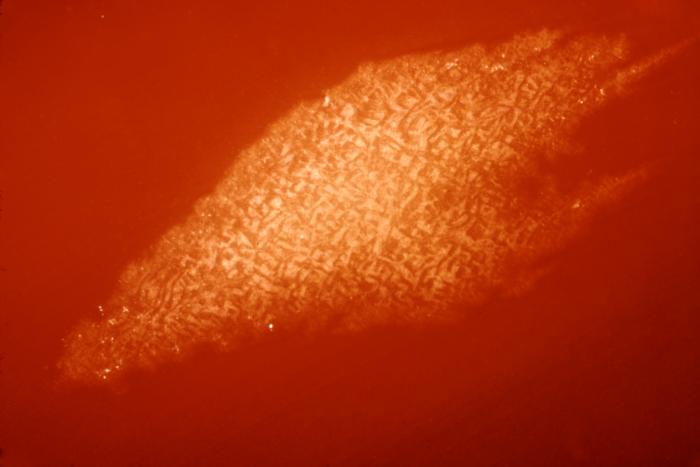
Shown below is an image of Clostridium botulinum type A colonies, Strain 2, grown on a 48hr blood agar plate. The bacterium C. botulinum produces a nerve toxin, which causes the rare, but serious paralytic illness Botulism. There are seven types of botulism toxin designated by the letters A through G; only types A, B, E and F cause illness in humans.

Shown below is an image of wound botulism involvement of compound fracture of right arm. 14-year-old boy fractured his right ulna and radius and subsequently developed wound botulism.
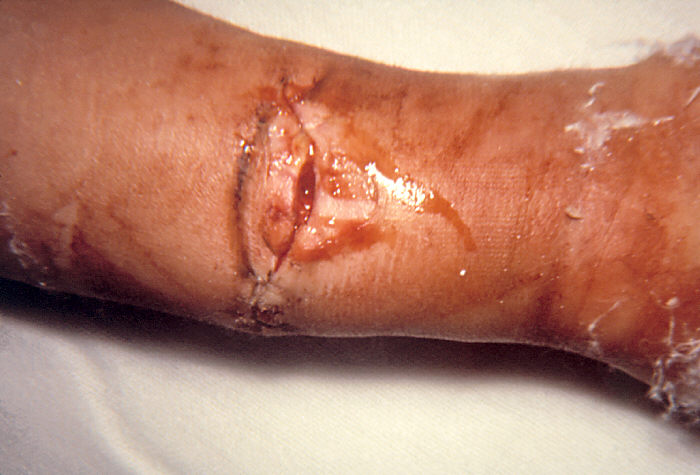
Shown below is an image of six week old infant with botulism, which is evident as a marked loss of muscle tone, especially in the region of the head and neck.

Microscopic Pathology
Shown below is an image of gram-stained micrograph of Clostridium botulinum Type-A in thioglycollate broth was incubated for 48hrs at 35°C. C. botulinum is the bacterium responsible for the condition known as botulism, producing a neurotoxin the effects of which may be neutralized by various therapeutic agents.
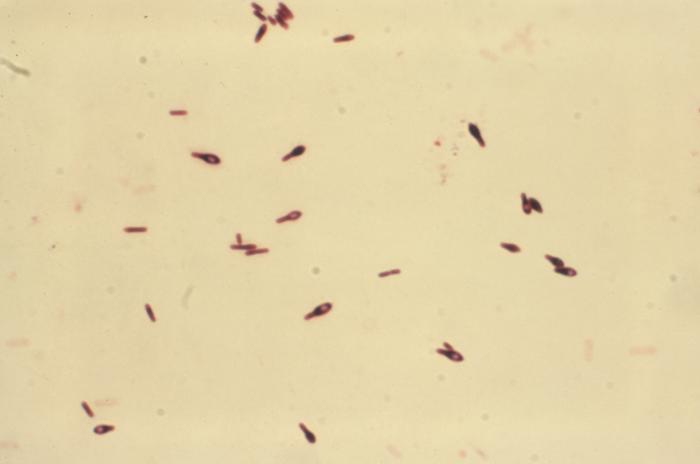
Shown below is an image of Clostridium botulinum spores stained with Malachite Green Stain. The endospores of C. botulinum when stained using the Malachite Green staining method will appear as green spheres, while the bacilli themselves will turn purple in color.
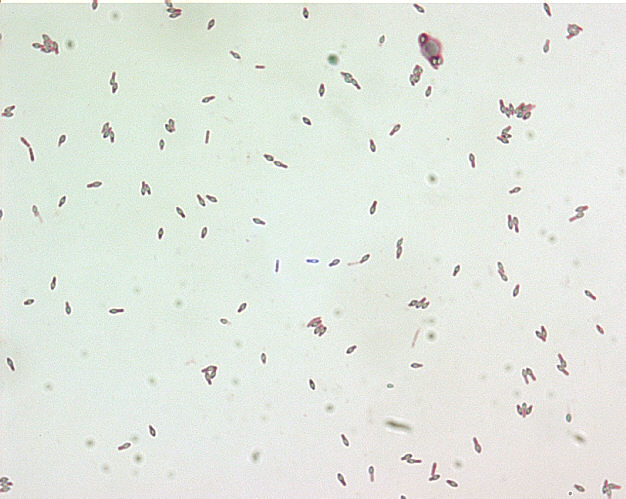
References
- ↑ Jump up to: 1.0 1.1 1.2 1.3 1.4 Arnon SS, Schechter R, Inglesby TV, Henderson DA, Bartlett JG, Ascher MS, Eitzen E, Fine AD, Hauer J, Layton M, Lillibridge S, Osterholm MT, O'Toole T, Parker G, Perl TM, Russell PK, Swerdlow DL, Tonat K (2001). "Botulinum toxin as a biological weapon: medical and public health management". JAMA : the Journal of the American Medical Association. 285 (8): 1059–70. PMID 11209178. Retrieved 2012-02-16. Unknown parameter
|month=ignored (help)CS1 maint: Multiple names: authors list (link)
Epidemiology and Demographics
|
Botulism Microchapters |
|
Diagnosis |
|---|
|
Treatment |
|
Case Studies |
|
Botulism On the Web |
|
American Roentgen Ray Society Images of Botulism |
Editor-In-Chief: C. Michael Gibson, M.S., M.D. [4]; Associate Editor(s)-in-Chief: Seyedmahdi Pahlavani, M.D. [5]
Overview
Globally, botulism is fairly rare. In the United States, for example, an average of 110 cases are reported each year. Of these, roughly 70% are infant botulism, 25% are foodborne botulism, and 5% are wound botulism. The number of cases of food borne and infant botulism has changed little in recent years, but wound botulism has increased because of the use of black tar heroin, especially in California.[1] Wound botulism may be caused even by inhaled cocaine.
Epidemiology
Incidence and prevalence
Globally, botulism is fairly rare. In the United States, for example, an average of 110 cases are reported each year. Of these, roughly 70% are infant botulism, 25% are foodborne botulism, and 5% are wound botulism. Infant botulism is predominantly sporadic and not associated with epidemics, but great geographic variability exists.[2] Approximately, a total number of 900 cases of infant botulism has been reported in the United States. From 1974 to 1996, for example, 47.2% of all infant botulism cases reported in the U.S. occurred in California.
Between 1990 and 2000, the Centers for Disease Control and Prevention reported 263 individual foodborne cases from 160 botulism events in the United States with a case-fatality rate of 4%. Thirty-nine percent (103 cases and 58 events) occurred in Alaska, all of which were attributable to traditional Alaska aboriginal foods. In the lower 49 states, home-canned food was implicated in 70 (91%) events with canned asparagus being the most numerous cause. Two restaurant-associated outbreaks affected 25 persons. The median number of cases per year was 23 (range 17–43), the median number of events per year was 14 (range 9–24). The highest incidence rates occurred in Alaska, Idaho, Washington, and Oregon. All other states had an incidence rate of 1 case per ten million people or less.[3]
The number of cases of food borne and infant botulism has changed little in recent years, but wound botulism has increased because of the use of black tar heroin, especially in California.[1] Wound botulism may be caused even by inhaled cocaine.
Outbreaks
The following table, summarizes foodborne botulism outbreaks.[4][5][6][7][8] Outbreaks defined as two or more cases resulting from a common exposure.
|
Race
There is no racial predilection of botulism.
Gender
Men and women are affected equally with botulism.
Age
- Infant botulism: Occurs in infants younger than 12 month of old.
- Foodborne and wound botulism: May occur in any ages.
Number of confirmed botulism cases by state and transmission category in the United States, 2015
References
- ↑ Jump up to: 1.0 1.1 Passaro, Douglas J.; Werner, Benson; McGee, Jim; Mac Kenzie, William R.; Vugia, Duc J. (1998). "Wound Botulism Associated With Black Tar Heroin Among Injecting Drug Users". JAMA. 279 (11): 859–63. doi:10.1001/jama.279.11.859. PMID 9516001.
- ↑ Pickett J, Berg B, Chaplin E, Brunstetter-Shafer MA (1976). "Syndrome of botulism in infancy: clinical and electrophysiologic study". N. Engl. J. Med. 295 (14): 770–2. doi:10.1056/NEJM197609302951407. PMID 785257.
- ↑ {{Cite journal |last=Sobel |first=Jeremy |publisher=Centers for Disease Control |date= September 2004 |title=Foodborne Botulism in the United States, 1990–2000 |url=http://www.cdc.gov/ncidod/EID/vol10no9/03-0745.htm |accessdate=September 29, 2010 |postscript=
- ↑ "Botulism from home-canned bamboo shoots--Nan Province, Thailand, March 2006". MMWR Morb. Mortal. Wkly. Rep. 55 (14): 389–92. 2006. PMID 16617285.
- ↑ "Botulism associated with commercial carrot juice--Georgia and Florida, September 2006". MMWR Morb. Mortal. Wkly. Rep. 55 (40): 1098–9. 2006. PMID 17035929.
- ↑ Zhang S, Wang Y, Qiu S, Dong Y, Xu Y, Jiang D, Fu X, Zhang J, He J, Jia L, Wang L, Zhang C, Sun Y, Song H (2010). "Multilocus outbreak of foodborne botulism linked to contaminated sausage in Hebei province, China". Clin. Infect. Dis. 51 (3): 322–5. doi:10.1086/653945. PMID 20569065.
- ↑ McCrickard L, Marlow M, Self JL, Watkins LF, Chatham-Stephens K, Anderson J, Hand S, Taylor K, Hanson J, Patrick K, Luquez C, Dykes J, Kalb SR, Hoyt K, Barr JR, Crawford T, Chambers A, Douthit B, Cox R, Craig M, Spurzem J, Doherty J, Allswede M, Byers P, Dobbs T (2017). "Notes from the Field: Botulism Outbreak from Drinking Prison-Made Illicit Alcohol in a Federal Correctional Facility - Mississippi, June 2016". MMWR Morb. Mortal. Wkly. Rep. 65 (52): 1491–1492. doi:10.15585/mmwr.mm6552a8. PMID 28056003.
- ↑ McCarty CL, Angelo K, Beer KD, Cibulskas-White K, Quinn K, de Fijter S, Bokanyi R, St Germain E, Baransi K, Barlow K, Shafer G, Hanna L, Spindler K, Walz E, DiOrio M, Jackson BR, Luquez C, Mahon BE, Basler C, Curran K, Matanock A, Walsh K, Slifka KJ, Rao AK (2015). "Large Outbreak of Botulism Associated with a Church Potluck Meal--Ohio, 2015". MMWR Morb. Mortal. Wkly. Rep. 64 (29): 802–3. PMID 26225479.
Risk Factors
|
Botulism Microchapters |
|
Diagnosis |
|---|
|
Treatment |
|
Case Studies |
|
Botulism On the Web |
|
American Roentgen Ray Society Images of Botulism |
Editor-In-Chief: C. Michael Gibson, M.S., M.D. [6]; Associate Editor(s)-in-Chief: Michael Maddaleni, B.S.
Overview
Botulism risk factors can be based upon the different types of the disease. The infants are more vulnerable to get infected with botulinum toxin. Honey and corn ingestion are common risk factors for the infants to get infected. Ingestion of preformed food and canned food increase the susceptibility of the infection. The intravenous drug abusers are vulnerable to get infected with wound botulism as well.
Risk Factors
Botulism risk factors can be characterized based on each type of botulism as follows:[1][2]
Infant botulism
Infants are especially vulnerable to botulism. Risk factors for infant botulism include:.[3][4]
- Living in rural areas
- Consuming corn or corn-containing products
- Penetrating trauma
- Being in contact with soil
- Honey intake
- Slow intestinal movement
Foodborne botulism
Using home canning methods increase risk for contracting botulism.
- Canned food such as:
- Fish
- Vegetables
- Beets
- Corn
- Spinach
- String beans
- Chili peppers
- Asparagus
- Honey
- Processed cheese
- Ingestion of foods that are not freshly prepared [5]
Canned foods provide an environment with optimal pH for clostridium botulinum to survive. Additionally, the anaerobic environment in canned products allows the bacteria to thrive.
Wound botulism
Wound botulism is a rare type of the disease yet, it is important to know the risk factors in order to completely prevent it. Wound botulism risk factors include the following:[6]
- Intravenous drug abuse
- Penetrating trauma with an infected object
References
- ↑ CDC https://www.cdc.gov/botulism/definition.html Accessed on May 21, 2017
- ↑ Midura TF (1996). "Update: infant botulism". Clin Microbiol Rev. 9 (2): 119–25. PMC 172885. PMID 8964030.
- ↑ Istre GR, Compton R, Novotny T, Young JE, Hatheway CL, Hopkins RS (1986). "Infant botulism. Three cases in a small town". Am J Dis Child. 140 (10): 1013–4. PMID 3529934.CS1 maint: Multiple names: authors list (link)
- ↑ Spika JS, Shaffer N, Hargrett-Bean N, Collin S, MacDonald KL, Blake PA (1989). "Risk factors for infant botulism in the United States". Am J Dis Child. 143 (7): 828–32. PMID 2741856.CS1 maint: Multiple names: authors list (link)
- ↑ Carter AT, Peck MW (2015). "Genomes, neurotoxins and biology of Clostridium botulinum Group I and Group II". Res Microbiol. 166 (4): 303–17. doi:10.1016/j.resmic.2014.10.010. PMC 4430135. PMID 25445012.
- ↑ Swedberg J, Wendel TH, Deiss F (1987). "Wound botulism". West J Med. 147 (3): 335–8. PMC 1025878. PMID 3314158.CS1 maint: Multiple names: authors list (link)
Causes
| style="background:#Template:Taxobox colour;"|Clostridium botulinum | ||||||||||||
|---|---|---|---|---|---|---|---|---|---|---|---|---|
| File:Clostridium botulinum 01.png Clostridium botulinum stained with gentian violet.
| ||||||||||||
| style="background:#Template:Taxobox colour;" | Scientific classification | ||||||||||||
| ||||||||||||
| Binomial name | ||||||||||||
| Clostridium botulinum van Ermengem, 1896 |
|
Botulism Microchapters |
|
Diagnosis |
|---|
|
Treatment |
|
Case Studies |
|
Botulism On the Web |
|
American Roentgen Ray Society Images of Botulism |
Editor-In-Chief: C. Michael Gibson, M.S., M.D. [7]
Overview
Clostridium botulinum is a Gram-positive, rod-shaped, anaerobic, spore-forming, motile bacterium with the ability to produce the neurotoxin botulinum.[1][2] The botulinum toxin can cause a severe flaccid paralytic disease in humans and animals[2] and is the most potent toxin known to humankind, natural or synthetic, with a lethal dose of 1.3-2.1ng/kg in humans.[3]
C. botulinum is a diverse group of bacteria initially grouped together by their ability to produce botulinum toxin and now known as four distinct groups, C. botulinum groups I-IV. C. botulinum groups I-IV, as well as some strains of Clostridium butyricum and Clostridium baratii, are the bacteria responsible for producing botulinum toxin.[1]
C. botulinum is responsible for foodborne botulism (ingestion of preformed toxin), infant botulism (intestinal infection with toxin forming C. botulinum), and wound botulism (infection of a wound with C. botulinum). C. botulinum produces heat-resistant endospores that are commonly found in soil and allow for survival in adverse conditions.[1]
Microbiology
C. botulinum is a Gram-positive, rod-shaped, spore-forming bacterium. It is an obligate anaerobe, meaning that oxygen is poisonous to the cells. However, C. botulinum tolerates traces of oxygen due to the enzyme superoxide dismutase, which is an important antioxidant defense in nearly all cells exposed to oxygen.[4] C. botulinum is only able to produce the neurotoxin during sporulation, which can only happen in an anaerobic environment. Other bacterial species produce spores in an unfavorable growth environment to preserve the organism's viability and permit survival in a dormant state until the spores are exposed to favorable conditions.
C. botulinum is divided in to four distinct phenotypic groups (I-IV) and is also classified into seven serotypes (A-G) based on the antigenicity of the botulinum toxin produced.[5][6] Recently, an eighth serotype (H) has been described.[7]
Groups
The classification into groups is based on the ability of the organism to digest complex proteins.[8][9] Studies at the DNA and rRNA level support the subdivision of the species into groups I-IV. Most outbreaks of human botulism are caused by group I (proteolytic) or II (non-proteolytic) C. botulinum. Group III organisms mainly cause diseases in animals. Group IV C. botulinum has not been shown to cause human or animal disease.
Botulinum toxin
Neurotoxin production is the unifying feature of the species. Eight types of toxins have been identified (including the recently described type H) that are allocated a letter (A-H).[7] All toxins are rapidly destroyed at 100°C, but they are resistant to degradation by enzymes found in the gastrointestinal tract. This allows for ingested toxin to be absorbed from the intestines into the bloodstream.[3]
Most strains produce one type of neurotoxin, but strains producing multiple toxins have been described. C. botulinum producing B and F toxin types have been isolated from human botulism cases in New Mexico and California.[10] The toxin type has been designated Bf as the type B toxin was found in excess to the type F. Similarly, strains producing Ab and Af toxins have been reported. Evidence indicates the neurotoxin genes have been the subject of horizontal gene transfer, possibly from a viral source. This theory is supported by the presence of integration sites flanking the toxin in some strains of C. botulinum. However, these integrations sites are degraded, indicating that the C. botulinum acquired the toxin genes quite far in the evolutionary past.
Botulinum toxin types
Only botulinum toxin types A, B, E, F, and H cause disease in humans. Types A, B, and E are associated with foodborne illness, with type E specifically associated with fish products. Type C produces limberneck in birds and type D causes botulism in other mammals. No disease is associated with type G.[11] The "gold standard" for determining toxin type is a mouse bioassay, but the genes for types A, B, E, and F can now be readily differentiated using quantitative PCR.[12]
A few strains from organisms genetically identified as other Clostridium species have caused human botulism: C. butyricum has produced type E toxin[13] and C. baratii had produced type F toxin.[14][15] The ability of C. botulinum to naturally transfer neurotoxin genes to other clostridia is concerning, especially in the food industry, where preservation systems are designed to destroy or inhibit only C. botulinum but not other Clostridium species.
An eighth toxin, type H, was discovered by researchers at the California Department of Public Health in 2013. With a lethal dose of 2 ng by injection or 13 ng by inhalation, it was deemed the most toxic substance on Earth.[7]
|
Properties |
Group I |
Group II |
Group III |
Group IV |
|---|---|---|---|---|
|
Toxin Types |
A, B, F | B, E, F | C, D | G |
|
Proteolysis |
+ | - | weak | - |
|
Saccharolysis |
- | + | - | - |
|
Disease host |
human | human | animal | - |
|
Toxin gene |
chromosome/plasmid | chromosome/plasmid | bacteriophage | plasmid |
|
Close relatives |
C. sporogenes, C. putrificum | C. butyricum, C. beijerinickii | C. haemolyticum, C. novyi type A | C. subterminale, C. haemolyticum |
Laboratory isolation
In the laboratory, C. botulinum is usually isolated in tryptose sulfite cycloserine (TSC) growth medium in an anaerobic environment with less than 2% oxygen. This can be achieved by several commercial kits that use a chemical reaction to replace O2 with CO2. C. botulinum is a lipase-positive microorganism that grows between pH of 4.8 and 7.0 and cannot use lactose as a primary carbon source, characteristics important for biochemical identification.[16]
Taxonomy history
C. botulinum was first recognized and isolated in 1895 by Emile van Ermengem from home-cured ham implicated in a botulism outbreak.[17] The isolate was originally named Bacillus botulinus, after the Latin word for sausage, botulus. ("Sausage poisoning" was a common problem in 18th- and 19th-century Germany, and was most likely caused by botulism)[18] However, isolates from subsequent outbreaks were always found to be anaerobic spore formers, so Ida A. Bengtson proposed that the organism be placed into the genus Clostridium, as the Bacillus genus was restricted to aerobic spore-forming rods.[19]
Since 1959, all species producing the botulinum neurotoxins (types A-G) have been designated C. botulinum. Substantial phenotypic and genotypic evidence exists to demonstrate heterogeneity within the species. This has led to the reclassification of C. botulinum type G strains as a new species, C. argentinense.[20]
Group I C. botulinum strains that do not produce a botulin toxin are referred to as C. sporogenes.[21]
The complete genome of C. botulinum has been sequenced at Sanger.[22]
C. botulinum in different geographical locations
A number of quantitative surveys for C. botulinum spores in the environment have suggested a prevalence of specific toxin types in given geographic areas, which remain unexplained.
North America
Type A C. botulinum predominates the soil samples from the western regions, while type B is the major type found in eastern areas.[23] The type-B organisms were of the proteolytic type I. Sediments from the Great Lakes region were surveyed after outbreaks of botulism among commercially reared fish, and only type E spores were detected.[24][25][26] In a survey, type-A strains were isolated from soils that were neutral to alkaline (average pH 7.5), while type-B strains were isolated from slightly acidic soils (average pH 6.25).
Europe
C. botulinum type E is prevalent in aquatic sediments in Norway and Sweden,[27] Denmark,[28] the Netherlands, the Baltic coast of Poland, and Russia.[23] The type-E C. botulinum was suggested to be a true aquatic organism, which was indicated by the correlation between the level of type-E contamination and flooding of the land with seawater. As the land dried, the level of type E decreased and type B became dominant.
In soil and sediment from the United Kingdom, C. botulinum type B predominates. In general, the incidence is usually lower in soil than in sediment. In Italy, a survey conducted in the vicinity of Rome found a low level of contamination; all strains were proteolytic C. botulinum types A or B.[29]
Australia
C. botulinum type A was found to be present in soil samples from mountain areas of Victoria.[30] Type-B organisms were detected in marine mud from Tasmania.[31] Type-A C. botulinum has been found in Sydney suburbs and types A and B were isolated from urban areas. In a well-defined area of the Darling-Downs region of Queensland, a study showed the prevalence and persistence of C. botulinum type B after many cases of botulism in horses.
Other
A "mouse protection" or "mouse bioassay" test determines the type of C. botulinum toxin present using monoclonal antibodies. An enzyme-linked immunosorbent assay (ELISA)with digoxigenin-labeled antibodies can also be used to detect the toxin,[32] and quantitative PCR can detect the toxin genes in the organism.[12]
C. botulinum is also used to prepare the medicaments Botox, Dysport, Xeomin, and Neurobloc used to selectively paralyze muscles to temporarily relieve muscle function. It has other "off-label" medical purposes, such as treating severe facial pain, such as that caused by trigeminal neuralgia.
Botulin toxin produced by C. botulinum is often believed to be a potential bioweapon as it is so potent that it takes about 75 nanograms to kill a person (Template:LD50 of 1 ng/kg,[33] assuming an average person weighs ~75 kg); 1 kilogram of it would be enough to kill the entire human population. For comparative purposes, a quarter of a typical grain of sand's weight (350 ng) of botulinum toxin would constitute a lethal dose for humans.
C. botulinum is a soil bacterium. The spores can survive in most environments and are very hard to kill. They can survive the temperature of boiling water at sea level, thus many foods are canned with a pressurized boil that achieves even higher temperatures, sufficient to kill the spores.
Growth of the bacterium can be prevented by high acidity, high ratio of dissolved sugar, high levels of oxygen, very low levels of moisture, or storage at temperatures below 3°C (38°F) for type A. For example in a low-acid, canned vegetable such as green beans that are not heated enough to kill the spores (i.e., a pressurized environment) may provide an oxygen-free medium for the spores to grow and produce the toxin. However, pickles are sufficiently acidic to prevent growth; even if the spores are present, they pose no danger to the consumer. Honey, corn syrup, and other sweeteners may contain spores, but the spores cannot grow in a highly concentrated sugar solution; however, when a sweetener is diluted in the low-oxygen, low-acid digestive system of an infant, the spores can grow and produce toxin. As soon as infants begin eating solid food, the digestive juices become too acidic for the bacterium to grow.
Gallery
-
Violet-stained culture specimen revealing the presence of numerous Gram-positive Clostridium botulinum. From Public Health Image Library (PHIL). [34]
-
Photomicrograph of Clostridium botulinum type A. From Public Health Image Library (PHIL). [34]
-
Photomicrograph of Clostridium botulinum type A. From Public Health Image Library (PHIL). [34]
References
- ↑ Jump up to: 1.0 1.1 1.2 Peck, MW (2009). "Biology and genomic analysis of Clostridium botulinum". Advances in microbial physiology. Advances in Microbial Physiology. 55: 183–265, 320. doi:10.1016/s0065-2911(09)05503-9. ISBN 9780123747907. PMID 19573697.
- ↑ Jump up to: 2.0 2.1 Lindström, M; Korkeala, H (Apr 2006). "Laboratory diagnostics of botulism". Clinical Microbiology Reviews. 19 (2): 298–314. doi:10.1128/cmr.19.2.298-314.2006. PMC 1471988. PMID 16614251.
- ↑ Jump up to: 3.0 3.1 (2010). Chapter 29. Clostridium, Peptostreptococcus, Bacteroides, and Other Anaerobes. In Ryan K.J., Ray C (Eds), Sherris Medical Microbiology, 5th ed. ISBN 978-0071604024
- ↑ Doyle, Michael P. (2007). Food Microbiology: Fundamentals and Frontiers. ASM Press. ISBN 1-55581-208-2.
- ↑ Peck, MW; Stringer, SC; Carter, AT. (2011). "Clostridium botulinum in the post-genomic era". Food Microbiol. 28 (2): 183–91. doi:10.1016/j.fm.2010.03.005. PMID 21315972.
- ↑ Shukla, HD; Sharma, SK. (2005). "Clostridium botulinum: a bug with beauty and weapon". Crit Rev Microbiol. 31 (1): 11–8. doi:10.1080/10408410590912952. PMID 15839401.
- ↑ Jump up to: 7.0 7.1 7.2 MacKenzie, Debora (14 October 2013). "New botox super-toxin has its details censored". NewScientist. Retrieved 15 October 2013.
- ↑ L. V. Holdeman, J. B. Brooks. 1970. Variation among strains of Clostridium botulinum and related clostridia. Protocols of the first U.S-Japan conference on Toxic Microorganisms. pp. 278–286
- ↑ L. D. S. Smith, G. Hobbs. 1974. Genus III Clostridium Prazmowski 1880, 23. In R. E. Buchanan, N. E. gibbons (eds.), Bergey’s Manual of Determinative Bacteriology, 8th ed. William & Wilkins, Baltimore. pp. 551–572. ISBN 978-0683006032
- ↑ Hatheway, C. L.; McCroskey, L. M. (1987). "Examination of faeces for diagnosis of infant botulism in 336 patients". J. Clin. Microbiol. 25 (12): 2334–2338. PMC 269483. PMID 3323228.
- ↑ (2013). Chapter 11. Spore-Forming Gram-Positive Bacilli: Bacillus and Clostridium Species. In Brooks G.F., Carroll K.C., Butel J.S., Morse S.A., Mietzner T.A. (Eds), Jawetz, Melnick, & Adelberg's Medical Microbiology, 26th ed. ISBN 978-0071790314
- ↑ Jump up to: 12.0 12.1 Satterfield, B. A.; Stewart, A. F.; Lew, C. S.; Pickett, D. O.; Cohen, M. N.; Moore, E. A.; Luedtke, P. F.; O'Neill, K. L.; Robison, R. A.; et al. (2010). "A quadruplex real-time PCR assay for rapid detection and differentiation of the Clostridium botulinum toxin genes A, B, E and F". J Med Microbiol. 59 (Pt 1): 55–64. doi:10.1099/jmm.0.012567-0. PMID 19779029.CS1 maint: Explicit use of et al. (link)
- ↑ Aureli, P.; Fenicia, L.; Pasolini, B.; Gianfrancesche, M.; Mccroskey, J. M.; Hatheway, C. L. (1986). "Two cases of type E infant botulism caused by neurotoxigenic Clostridium botulinum in Italy". J. Infect. Dis. 154 (2): 207–211. doi:10.1093/infdis/154.2.207. PMID 3722863.
- ↑ Hall, J. D.; McCroskey, L. M.; Pincomb, B. J.; Hatheway, C. L. (1985). "Isolation of an organism resembling Clostridium baratii which produces a type F botulinal toxin from an infant with botulism". J. Clin. Microbiol. 21 (4): 654–655. PMC 271744. PMID 3988908.
- ↑ Notermans, S.; Havellar, A. H. (1980). "Removal and inactivation of botulinum toxin during production of drinking water from surface water". Antonie van Leeuwenhoek. 46 (5): 511–514. doi:10.1007/BF00395840.
- ↑ . (2005). Brock Biology of Microorganisms (11th ed.). Prentice Hall. ISBN 0-13-144329-1.
- ↑ E. van Ergmengem. 1897. Über einen neuen anaeroben Bacillus und seine Beziehungen Zum Botulismus. Zentralbl. Hyg. Infektionskr. 26:1–8.
- ↑ Frank J. Erbguth. Historical notes on botulism, Clostridium botulinum, botulinum toxin, and the idea of the therapeutic use of the toxin. Movement Disorders. Volume 19, Issue S8, pages S2-S6, March 2004.
- ↑ I. A. Bengston. 1924. Studies on organisms concerned as causative factors in botulism. Hyg. Lab. Bull. 136:101
- ↑ J. C. Suen, C. L. Hatheway, A. G. Steigerwalt, D. J. Brenner. 1988, Clostridium argentinense sp.nov.: a genetically homogeneous group composed of all strains of Clostridium botulinum type G and some nontoxigenic strains previously identified as Clostridium subterminale or Clostridium hastiforme. Int. J. Sys. Bacteriol. 38:375–381.
- ↑ Judicial Commission of the International Committee on Systematic Bacteriology (1999) Rejection of Clostridium putrificum and conservation of Clostridium botulinum and Clostridium sporogenes Opinion 69. International Journal of Systematic Bacteriology. 49:339.
- ↑ http://www.sanger.ac.uk/Projects/C_botulinum/
- ↑ Jump up to: 23.0 23.1 A. H. W. Hauschild. 1989. Clostridium botulinum. In M. P. Doyle (ed.), Food-borne Bacterial Pathogens. Marcel Dekker, New York. Pp. 111–189
- ↑ Bott, T. L.; Johnson, J.; Foster, E. M.; Sugiyama, H. (1968). "Possible origin of the fish incidences of Clostridium botulinum type E in an inland bay (Green Bay of Lake Michigan)". J. Bacteriol. 95: 1542.
- ↑ M. W. Eklund, M. E. Peterson, F. T. Poysky, L. W. Peck, J. F. Conrad. 1982. Botulism in juvenile Coho salmon (Onocorhynchus kisutch) in the United States. Aquaculture 27:1–11
- ↑ M. W. Eklund, F. T. Poysky M. E. Peterson, L. W. Peck, Brunson. 1984. Type E botulism in salmonids and conditions contributing to outbreaks. Aquaculture 41:293–309.
- ↑ A. Johannsen. 1963. Clostridium botulinum in Sweden and the adjacent waters. J. Appl. Bacteriol. 26:43–47.
- ↑ Huss, H. H. (1980). "Distribution of Clostridium botulinum". Appl. Environ. Microbiol. 39 (4): 764–769. PMC 291416. PMID 6990867.
- ↑ Creti, R.; Fenicia, J.; Aureli, P. (1990). "Occurrence of Clostridium botulinum in the soil of the vicinity of Rome". Curr. Microbiol. 20 (5): 317. doi:10.1007/bf02091912.
- ↑ Eales, C. E.; Gillespie, J. M. (1947). "the isolation of Clostridium botulinum type A from Victorian soils. Aust. J". Sci. 10: 20–21.
- ↑ Ohye, W. J. Scott (1957). "Studies in the physiology of Clostridium botulinum type E. Aust. L. Biol". Sci. 10: 85–94.
- ↑ Shashi K. Sharma, Joseph. L. Ferreira, Brian S. Eblen and Richard C. Whitingand. Detection of Type A, B, E, and F Clostridium botulinum Neurotoxins in Foods by Using an Amplified Enzyme-Linked Immunosorbent Assay with Digoxigenin-Labeled Antibodies. Appl. Environ. Microbiol. February 2006 vol. 72 no. 2 1231-1238. doi:10.1128/AEM.72.2.1231-1238.2006
- ↑ Fleming, Diane O. "Biological Safety: principles and practices". ASM Press. 2000: 267.
- ↑ Jump up to: 34.0 34.1 34.2 "Public Health Image Library (PHIL)".
External links
- Pathema-Clostridium Resource
- Jeremy Sobel (2005). "Botulism". Clinical Infectious Diseases. 41 (8): 1167–1173. doi:10.1086/444507. PMID 16163636.
- Current research on Clostridium botulinum at the Norwich Research Park
| Firmicutes/ (low-G+C) | |
|---|---|
| Actinobacteria/ (high-G+C) | |
Lua error in Module:Authority_control at line 788: attempt to index field 'wikibase' (a nil value).
Differential Diagnosis
|
Botulism Microchapters |
|
Diagnosis |
|---|
|
Treatment |
|
Case Studies |
|
Botulism On the Web |
|
American Roentgen Ray Society Images of Botulism |
Editor-In-Chief: C. Michael Gibson, M.S., M.D. [8]; Associate Editor(s)-in-Chief: Michael Maddaleni, B.S., Tarek Nafee, M.D. [9]
Overview
Botulism must be differentiated from neuromuscular disorders, neurotoxins, infections, and vascular diseases that present with muscle weakness, hypotonia, and flaccidity.
Differentiating Botulism from other Diseases
Botulism must be differentiated from neuromuscular disorders, neurotoxins, infections, and vascular diseases that present with muscle weakness, hypotonia, and flaccidity such as:
| Diseases | History and Physical | Diagnostic tests | Other Findings | ||||||||
|---|---|---|---|---|---|---|---|---|---|---|---|
| Motor Deficit | Sensory deficit | Cranial nerve Involvement | Autonomic dysfunction | Proximal/Distal/Generalized | Ascending/Descending/Systemic | Unilateral (UL)
or Bilateral (BL) or No Lateralization (NL) |
Onset | Lab or Imaging Findings | Specific test | ||
| Adult Botulism | + | - | + | + | Generalized | Descending | BL | Sudden | Toxin test | Blood, Wound, or Stool culture | Diplopia, Hyporeflexia, Hypotonia, possible respiratory paralysis |
| Infant Botulism | + | - | + | + | Generalized | Descending | BL | Sudden | Toxin test | Blood, Wound, or Stool culture | Flaccid paralysis (Floppy baby syndrome), possible respiratory paralysis |
| Guillian-Barre syndrome[1] | + | - | - | - | Generalized | Ascending | BL | Insidious | CSF: ↑Protein
↓Cells |
Clinical & Lumbar Puncture | Progressive ascending paralysis following infection, possible respiratory paralysis |
| Eaton Lambert syndrome[2] | + | - | + | + | Generalized | Systemic | BL | Intermittent | EMG, repetitive nerve stimulation test (RNS) | Voltage gated calcium channel (VGCC) antibody | Diplopia, ptosis, improves with movement (as the day progresses) |
| Myasthenia gravis[3] | + | - | + | + | Generalized | Systemic | BL | Intermittent | EMG, Edrophonium test | Ach receptor antibody | Diplopia, ptosis, worsening with movement (as the day progresses) |
| Electrolyte disturbance[4] | + | + | - | - | Generalized | Systemic | BL | Insidious | Electrolyte panel | ↓Ca++, ↓Mg++, ↓K+ | Possible arrhythmia |
| Organophosphate toxicity[5] | + | + | - | + | Generalized | Ascending | BL | Sudden | Clinical diagnosis: physical exam & history | Clinical suspicion confirmed with RBC AchE activity | History of exposure to insecticide or living in farming environment. with : Diarrhea, Urination, Miosis, Bradycardia, Lacrimation, Emesis, Salivation, Sweating |
| Tick paralysis (Dermacentor tick)[6] | + | - | - | - | Generalized | Ascending | BL | Insidious | Clinical diagnosis: physical exam & history | - | History of outdoor activity in Northeastern United States. The tick is often still latched to the patient at presentation (often in head and neck area) |
| Tetrodotoxin poisoning[7] | + | - | + | + | Generalized | Systemic | BL | Sudden | Clinical diagnosis: physical exam & dietary history | - | History of consumption of puffer fish species. |
| Stroke[8] | +/- | +/- | +/- | +/- | Generalized | Systemic | UL | Sudden | MRI +ve for ischemia or hemorrhage | MRI | Sudden unilateral motor and sensory deficit in a patient with a history of atherosclerotic risk factors (diabetes, hypertension, smoking) or atrial fibrillation. |
| Poliomyelitis[9] | + | + | + | +/- | Proximal > Distal | Systemic | BL or UL | Sudden | PCR of CSF | Asymmetric paralysis following a flu-like syndrome. | |
| Transverse myelitis[10] | + | + | + | + | Proximal > Distal | Systemic | BL or UL | Sudden | MRI & Lumbar puncture | MRI | History of chronic viral or autoimmune disease (e.g. HIV) |
| Neurosyphilis[11][12] | + | + | - | +/- | Generalized | Systemic | BL | Insidious | MRI & Lumbar puncture | CSF VDRL-specifc | History of unprotected sex or multiple sexual partners.
History of genital ulcer (chancre), diffuse maculopapular rash. |
| Muscular dystrophy[14] | + | - | - | - | Proximal > Distal | Systemic | BL | Insidious | Genetic testing | Muscle biopsy | Progressive proximal lower limb weakness with calf pseudohypertrophy in early childhood. Gower sign positive. |
| Multiple sclerosis exacerbation[15] | + | + | + | + | Generalized | Systemic | NL | Sudden | ↑CSF IgG levels
(monoclonal) |
Clinical assessment and MRI [16] | Blurry vision, urinary incontinence, fatigue |
| Amyotrophic lateral sclerosis[17] | + | - | - | - | Generalized | Systemic | BL | Insidious | Normal LP (to rule out DDx) | MRI & LP | Patient initially presents with upper motor neuron deficit (spasticity) followed by lower motor neuron deficit (flaccidity). |
| Inflammatory myopathy[18] | + | - | - | - | Proximal > Distal | Systemic | UL or BL | Insidious | Elevated CK & Aldolase | Muscle biopsy | Progressive proximal muscle weakness in 3rd to 5th decade of life. With or without skin manifestations. |
References
- ↑ Talukder RK, Sutradhar SR, Rahman KM, Uddin MJ, Akhter H (2011). "Guillian-Barre syndrome". Mymensingh Med J. 20 (4): 748–56. PMID 22081202.CS1 maint: Multiple names: authors list (link)
- ↑ Merino-Ramírez MÁ, Bolton CF (2016). "Review of the Diagnostic Challenges of Lambert-Eaton Syndrome Revealed Through Three Case Reports". Can J Neurol Sci. 43 (5): 635–47. doi:10.1017/cjn.2016.268. PMID 27412406.
- ↑ Gilhus NE (2016). "Myasthenia Gravis". N Engl J Med. 375 (26): 2570–2581. doi:10.1056/NEJMra1602678. PMID 28029925.
- ↑ Ozono K (2016). "[Diagnostic criteria for vitamin D-deficient rickets and hypocalcemia-]". Clin Calcium. 26 (2): 215–22. doi:CliCa1602215222 Check
|doi=value (help). PMID 26813501. - ↑ Kamanyire R, Karalliedde L (2004). "Organophosphate toxicity and occupational exposure". Occup Med (Lond). 54 (2): 69–75. PMID 15020723.
- ↑ Pecina CA (2012). "Tick paralysis". Semin Neurol. 32 (5): 531–2. doi:10.1055/s-0033-1334474. PMID 23677663.
- ↑ Bane V, Lehane M, Dikshit M, O'Riordan A, Furey A (2014). "Tetrodotoxin: chemistry, toxicity, source, distribution and detection". Toxins (Basel). 6 (2): 693–755. doi:10.3390/toxins6020693. PMC 3942760. PMID 24566728.CS1 maint: Multiple names: authors list (link)
- ↑ Kuntzer T, Hirt L, Bogousslavsky J (1996). "[Neuromuscular involvement and cerebrovascular accidents]". Rev Med Suisse Romande. 116 (8): 605–9. PMID 8848683.CS1 maint: Multiple names: authors list (link)
- ↑ Laffont I, Julia M, Tiffreau V, Yelnik A, Herisson C, Pelissier J (2010). "Aging and sequelae of poliomyelitis". Ann Phys Rehabil Med. 53 (1): 24–33. doi:10.1016/j.rehab.2009.10.002. PMID 19944665.CS1 maint: Multiple names: authors list (link)
- ↑ West TW (2013). "Transverse myelitis--a review of the presentation, diagnosis, and initial management". Discov Med. 16 (88): 167–77. PMID 24099672.
- ↑ Liu LL, Zheng WH, Tong ML, Liu GL, Zhang HL, Fu ZG; et al. (2012). "Ischemic stroke as a primary symptom of neurosyphilis among HIV-negative emergency patients". J Neurol Sci. 317 (1–2): 35–9. doi:10.1016/j.jns.2012.03.003. PMID 22482824.CS1 maint: Explicit use of et al. (link) CS1 maint: Multiple names: authors list (link)
- ↑ Berger JR, Dean D (2014). "Neurosyphilis". Handb Clin Neurol. 121: 1461–72. doi:10.1016/B978-0-7020-4088-7.00098-5. PMID 24365430.
- ↑ Ho EL, Marra CM (2012). "Treponemal tests for neurosyphilis--less accurate than what we thought?". Sex Transm Dis. 39 (4): 298–9. doi:10.1097/OLQ.0b013e31824ee574. PMC 3746559. PMID 22421697.
- ↑ Falzarano MS, Scotton C, Passarelli C, Ferlini A (2015). "Duchenne Muscular Dystrophy: From Diagnosis to Therapy". Molecules. 20 (10): 18168–84. doi:10.3390/molecules201018168. PMID 26457695.CS1 maint: Multiple names: authors list (link)
- ↑ Filippi M, Preziosa P, Rocca MA (2016). "Multiple sclerosis". Handb Clin Neurol. 135: 399–423. doi:10.1016/B978-0-444-53485-9.00020-9. PMID 27432676.CS1 maint: Multiple names: authors list (link)
- ↑ Giang DW, Grow VM, Mooney C, Mushlin AI, Goodman AD, Mattson DH; et al. (1994). "Clinical diagnosis of multiple sclerosis. The impact of magnetic resonance imaging and ancillary testing. Rochester-Toronto Magnetic Resonance Study Group". Arch Neurol. 51 (1): 61–6. PMID 8274111.CS1 maint: Explicit use of et al. (link) CS1 maint: Multiple names: authors list (link)
- ↑ Riva N, Agosta F, Lunetta C, Filippi M, Quattrini A (2016). "Recent advances in amyotrophic lateral sclerosis". J Neurol. 263 (6): 1241–54. doi:10.1007/s00415-016-8091-6. PMC 4893385. PMID 27025851.CS1 maint: Multiple names: authors list (link)
- ↑ Michelle EH, Mammen AL (2015). "Myositis Mimics". Curr Rheumatol Rep. 17 (10): 63. doi:10.1007/s11926-015-0541-0. PMID 26290112.
Natural History, Complications & Prognosis
Natural History
|
Botulism Microchapters |
|
Diagnosis |
|---|
|
Treatment |
|
Case Studies |
|
Botulism On the Web |
|
American Roentgen Ray Society Images of Botulism |
Editor-In-Chief: C. Michael Gibson, M.S., M.D. [10]; Associate Editor(s)-in-Chief: Seyedmahdi Pahlavani, M.D. [11]
Overview
If botulism left untreated it may cause respiratory failure and even death. Common complications of botulism include, respiratory failure, difficult swallowing, speech difficulties, fatigue, and death. Botulism's prognosis depends on the amount of the ingested toxins and prompt treatment.
Natural History
The symptoms of foodborne botulism often develop few days after ingestion of toxin produced in food by C. botulinum. The most frequent source is home-canned foods, prepared in an unsafe manner. Wound botulism occurs when C. botulinum spores germinate within wounds. Infant botulism occurs when C. botulinum spores germinate and produce toxin in the gastrointestinal tract of infants. If botulism left untreated it may cause respiratory failure and even death.[1][2]
Complications
Infant botulism has no long-term side effects, but can be complicated by nosocomial adverse events. The case fatality rate is less than 1% for hospitalized infants with botulism.
Important complications of botulism include:[3][1][2]
- Respiratory muscle weakness and impending respiratory failure
- Long-lasting weakness
- Difficult swallowing
- Speech difficulties
- Fatigue
- Death from botulism mainly occurs from a few reasons:
- Respiratory failure, possibly due to a delayed diagnosis.
- Complications in the hospital such as a nosocomial infection, mostly due to pneumonia.
Prognosis
The prognosis depends on the type of toxin. The amount of botulinum toxin an individual is exposed to will play a role in the overall prognosis, but early treatment will significantly decrease the chance of death.[4]
There are, in fact, 7 different forms of the toxin. Type A generally causes the most severe form of botulism. An overall mortality rate of approximately 5-10% is suspected for the foodborne form of Botulism. Patients older than 60 years carry a higher risk of mortality than the general population..[5] The mortality rate of infant botulism is much lower; usually less than 1%.
Wound botulism is, on average, more fatal than foodborne botulism. Wound botulism carries a mortality rate of approximately 15%.[2]
The recovery period for botulism is fairly long. It ranges from approximately 30 to around 100 days. Sometimes patients need to stay on a ventilator for a long period of time to assist with breathing. There can also be a period of generalized weakness for up to a year after recovery from botulism.
References
- ↑ Jump up to: 1.0 1.1 Sobel J, Malavet M, John S (2007). "Outbreak of clinically mild botulism type E illness from home-salted fish in patients presenting with predominantly gastrointestinal symptoms". Clin. Infect. Dis. 45 (2): e14–6. doi:10.1086/518993. PMID 17578769.
- ↑ Jump up to: 2.0 2.1 2.2 Varma JK, Katsitadze G, Moiscrafishvili M, Zardiashvili T, Chokheli M, Tarkhashvili N, Jhorjholiani E, Chubinidze M, Kukhalashvili T, Khmaladze I, Chakvetadze N, Imnadze P, Hoekstra M, Sobel J (2004). "Signs and symptoms predictive of death in patients with foodborne botulism--Republic of Georgia, 1980-2002". Clin. Infect. Dis. 39 (3): 357–62. doi:10.1086/422318. PMID 15307002.
- ↑ Sobel J (2005). "Botulism". Clin. Infect. Dis. 41 (8): 1167–73. doi:10.1086/444507. PMID 16163636.
- ↑ David WS, Temin ES, Kraeft JJ, Hooper DC (2015). "Case records of the Massachusetts General Hospital. Case 3-2015. A 60-year-old woman with abdominal pain, dyspnea, and diplopia". N. Engl. J. Med. 372 (4): 364–72. doi:10.1056/NEJMcpc1410936. PMID 25607430.
- ↑ Hughes JM, Blumenthal JR, Merson MH, Lombard GL, Dowell VR, Gangarosa EJ (1981). "Clinical features of types A and B food-borne botulism". Ann. Intern. Med. 95 (4): 442–5. PMID 7283294.
Diagnosis
{{#ask:Used To Diagnose::Botulism |?Sort Order |format=list |headers=hide |link=none |sep= | |template=MedicalTestQuery |sort=Sort Order }}
Treatment
{{#ask:Used To Treat::Botulism |?Sort Order |format=list |headers=hide |link=none |sep= | |template=MedicalTreatmentQuery |sort=Sort Order }} {{#ask:Prevents::Botulism |?Sort Order |intro= | |format=list |headers=hide |link=none |sep= | |template=MedicalTreatmentQuery2 |sort=Sort Order }}
- Pages with reference errors
- CS1 errors: PMID
- CS1 maint: Multiple names: authors list
- Pages with citations using unsupported parameters
- CS1 maint: Explicit use of et al.
- Pages with script errors
- CS1 errors: DOI
- Pediatrics
- Neonatology
- Foodborne illnesses
- Biological weapons
- Conditions diagnosed by stool test
- Poultry diseases
- Zoonoses
- Neurology
- Emergency medicine
- Disease
- Bacterial diseases
- Bacteria
- Clostridiaceae
- Gram-positive bacteria
- Neurotoxins
- Botulism
- Infectious disease
Table of Contents In Alphabetical Order | By Individual Diseases | Signs and Symptoms | Physical Examination | Lab Tests | Drugs
Editor Tools Create a New Page | Become an Editor | Editors Help Menu | Upload a Picture or File | Maintain Pages | What Pages Link HereThere is no pharmaceutical or device industry support for this site and we need your viewer supported Donations | Editorial Board | Governance | Licensing | Disclaimers | Avoid Plagiarism | Policies
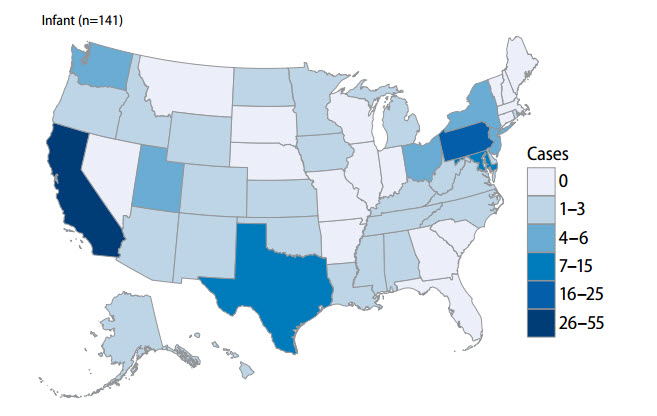
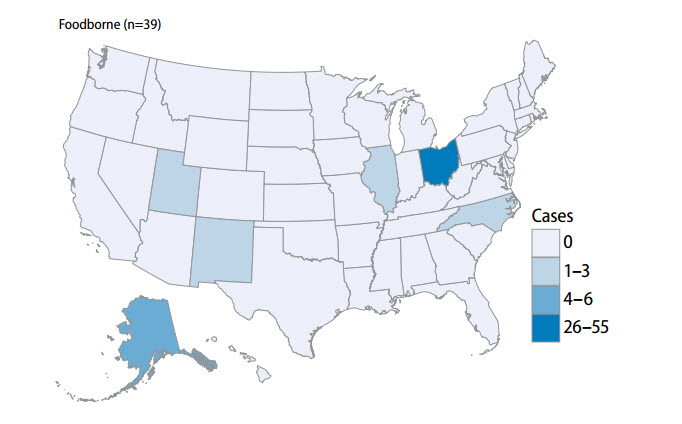
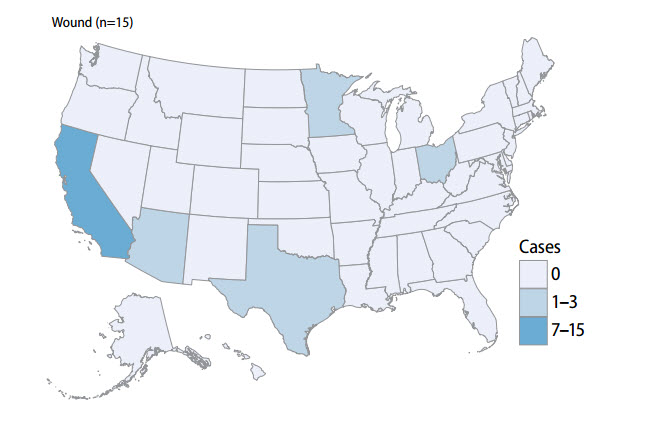
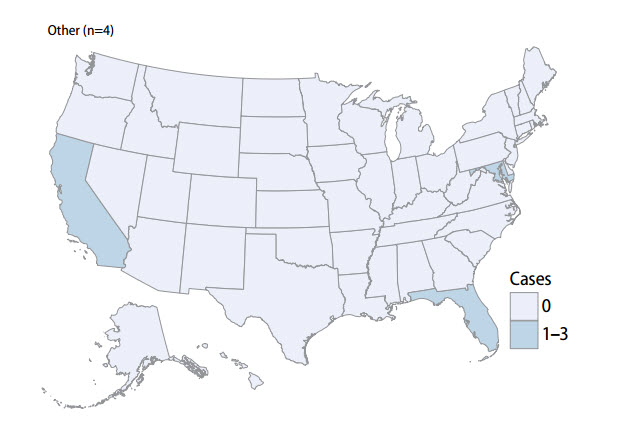
![Violet-stained culture specimen revealing the presence of numerous Gram-positive Clostridium botulinum. From Public Health Image Library (PHIL). [34]](/images/a/a0/Botulism15.jpeg)
![Photomicrograph of Clostridium botulinum type A. From Public Health Image Library (PHIL). [34]](/images/7/76/Botulism14.jpeg)
![Photomicrograph of Clostridium botulinum type A. From Public Health Image Library (PHIL). [34]](/images/e/ed/Botulism13.jpeg)